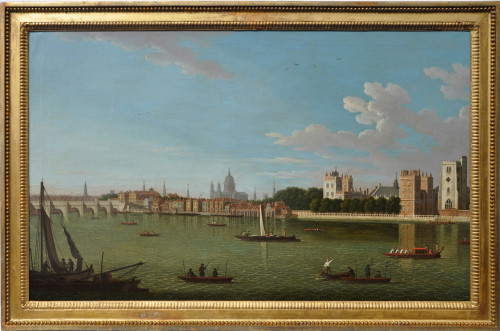A View of the Canal of Fontainebleau
A View of the Canal of Fontainebleau
Circle of JOHN INIGO RICHARDS
1731-1810
English School
A View of the Canal of Fontainebleau
Oil on canvas, inscribed
59.5 x 121 cms
233/8 x 475/8 inches
Overall framed size 71.3 x 132.7 cms
281/8 x 521/4 ins
John Inigo Richards was a London artist, born there in 1731 and dying in the same city 18th December 1810. He studied painting at the St. Martin's Lane Academy where he was taught by the renowned scenographer and topographical and imaginary landscape artist George Lambert (1700-1765) who has earned the sobriquet "Founder of British Landscape Painting".
Richards quickly established a reputation as a scene painter in the theatres of London, a route taken by the eminent history, genre and portrait painter Francis Hayman (c.1708-1776) when he started out as an artist. Hayman had worked principally at Drury Lane but Richards' main employer was the Covent Garden theatre, as it had been also for George Lambert, and Richards started there in 1759. An associate painter at Covent Garden was Giovanni Battista Cipriani, an Italian-born artist who became a significant force behind the English neo-Classical style. In spite of progressing on to other genres of painting, Richards never lost his enthusiasm for theatre design and was principal painter at Covent Garden between 1777 and 1803, succeeding Nicholas Thomas Dall in that position.
In his other guise as a landscape artist, Richards was chiefly a painter of topographical and decorative landscapes. He depicted scenes in the West Country, Kent, Sussex and Surrey as well as in Wales and Ireland as well as Italy but it is doubtful that he ever visited the latter, probably taking inspiration from other Grand Tour paintings or prints. These were sent from addresses in Soho, Covent Garden, Long Acre and Hoxton to exhibitions at the Royal Academy, the Society of Artists of Great Britain and the Free Society of Artists from 1762 to 1800. Titles include: "A View in Rome", "The Colosseum", "A View of part of the remains of Battle Abbey, Sussex", "View of a Cascade at Hester Combe in Somersetshire" and "Nymphs bathing". He also painted commission work for wealthy patrons - such as "Cowick Hall, Yorkshire, seen from the North with the Family of the 3rd Viscount Downe in Conversation on the Lawn" - which were not shown at the London exhibitions. These elegant topographical scenes show the influence of Canaletto which had beset English painting with the way the staffage was portrayed and in the airiness of the landscape.
John Inigo Richards was one of the thirty-four founder members of the Royal Academy together with such important artists as Reynolds, Gainsborough, Zuccarelli, Zoffany, Benjamin West, Angelica Kauffman and Richard Wilson when it was inaugurated on 10th December 1768. He became Secretary of the RA in 1788, remaining in the post until his death. In 1795 the Academy paid Richards twelve guineas to carry out conservation work on Leonardo da Vinci's "Virgin and Child with St Anne and John the Baptist" which is now in the National Gallery. He also catalogued and made an inventory of the entire collection of works of art in the RA.
The likeness of Richards can be seen in "The Academicians of the Royal Academy" painted by Johann Zoffany as well as in "Royal Academicians" by Henry Singleton. George Dance painted a portrait in profile of him which was subsequently engraved by William Daniel.
At his death in 1810 Richards acknowledged that the actress Ann Pitt had born his child, Mary Ann Richards, in 1759. As a form of recompense, he left his daughter a snuff box which was decorated with a picture of her mother and himself.
Works by John Inigo Richards can be seen in the collections of Tate Britain; National Museum of Wales in Cardiff; Government Art collection, the National Trust and the Hepworth in Wakefield.
Dictionary of British Landscape Painters - M H Grant
British Landscape Painting of the 18th Century - Luke Hermann
Watercolour Painting in Britain; 18th Century - Martin Hardie
The Artist and the Country House - John Harris
British Landscape Painting - Michael Rosenthal
This painting was probably produced for an English commission, possibly as part of an overmantel mirror where the top section contained a painting, often depicting a classical capriccio or sometimes a hunting subject after an artist such as James Ross. This example could be based on a print of a work by an 18th century French painter such as Jacques François Chereau (1680-1729) or one of the decorative Paris print scenes emanating from the engraving house of Basset à Rue Saint-Jacques.
1731 - 1810
Oil on canvas
England
Original canvas
RELATED ITEMS

























